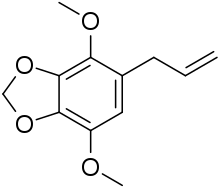Apiole
Apiole is a phenylpropene, also known as apiol, parsley apiol, or parsley camphor. Its chemical name is 1-allyl-2,5-dimethoxy-3,4-methylenedioxybenzene. It is found in the essential oils of celery leaf and all parts of parsley.[1] Heinrich Christoph Link, an apothecary in Leipzig, discovered the substance in 1715 as greenish crystals reduced by steam from oil of parsley.[2] In 1855 Joret and Homolle discovered that apiol was an effective treatment of amenorrea or lack of menstruation.
 | |
 | |
| Names | |
|---|---|
| Preferred IUPAC name
4,7-Dimethoxy-5-(prop-2-en-1-yl)-2H-1,3-benzodioxole | |
| Other names
5-Allyl-4,7-dimethoxybenzo[d][1,3]dioxole 1-Allyl-2,5-dimethoxy-3,4-methylenedioxybenzene | |
| Identifiers | |
3D model (JSmol) |
|
| ChEBI | |
| ChEMBL | |
| ChemSpider | |
| ECHA InfoCard | 100.007.592 |
| EC Number |
|
| KEGG | |
PubChem CID |
|
| UNII | |
CompTox Dashboard (EPA) |
|
| |
| |
| Properties | |
| C12H14O4 | |
| Molar mass | 222.23 g/mol |
| Density | 1.151 g/mL |
| Melting point | 30 °C (86 °F; 303 K) |
| Boiling point | 294 °C (561 °F; 567 K) |
Except where otherwise noted, data are given for materials in their standard state (at 25 °C [77 °F], 100 kPa). | |
| Infobox references | |
In medicine it has been used, as essential oil or in purified form, for the treatment of menstrual disorders and as an abortifacient. It is an irritant and, in high doses, it can cause liver and kidney damage.[3] Cases of death due to attempted abortion using apiole have been reported.[4][5]
Hippocrates wrote about parsley as an herb to cause an abortion.[6] Plants containing apiole were used by women in the Middle Ages to terminate pregnancies. Now that safer methods of abortion are available, apiol is almost forgotten.
According to a book called PIHKAL, Apiole had been used to synthesize a psychedelic amphetamine called DMMDA.
Apiol or apiole?
Apiole (always with the final 'e') is the correct spelling of the trivial name for 1-allyl-2,5-dimethoxy-3,4-methylenedioxybenzene.[7] Apiol, also known as 'liquid apiol' or 'green oil of parsley' is the extracted oleoresin of parsley, rather than the distilled oil. Its use was widespread in the USA, often as ergoapiol or apergol, until a highly toxic adulterated product containing apiol and tri-ortho-cresyl phosphate (also famous as the adulterant added to Jamaican ginger) was introduced on the American market. 1'-sulfoxy metabolite formation for apiole (3,4-OMe-safrole) is about 1/3 as active as safrole.[8] No carcinogenicity was detected with parsley apiol or dill apiol in mice.[9]
Other similarly named compounds
The name apiole is also used for a closely related compound found in dill and in fennel roots, the positional isomer (dillapiole, 1-allyl-2,3-dimethoxy-4,5-methylenedioxybenzene. Exalatacin (1-allyl-2,6-dimethoxy-3,4-methylenedioxybenzene) is another positional isomer of apiole, found in the Australian plants Crowea exalata and Crowea angustifolia var. angustifolia.
See also
References
- Azeez, Shamina; Krishnamurthy, K. (2008). Chemistry of Spices. Calicut, Kerala, India: Biddles Ltd. pp. 380 & 404. ISBN 9781845934057.
- Shorter, Edward (1991). Women's Bodies: A Social History of Women's Encounter With Health, Ill-Health, and Medicine. New Brunswick, NJ: Transaction Publishers.
- Amerio A; De Benedictis G; Leondeff J; et al. (Jan–Apr 1968). "Nephropathy due to apiol". Minerva Nefrol (in Italian). 15 (1). pp. 49–70.
- Quinn LJ; Harris C; Joron GE (Apr 15, 1958). "Apiol poisoning". Can Med Assoc J. 78 (8). pp. 635–6.
- Hermann K; Le Roux A; Fiddes FS (Jun 16, 1956). "Death from apiol used as abortifacient". Lancet. 270 (6929). pp. 937–9.
- Sage-Femme Collective (2008). Natural Liberty: Rediscovering Self-Induced Abortion Methods. Sage-Femme Collective. ISBN 978-0964592001.
- Shulgin AT, Dr. (Apr 23, 1966). "Possible implication of myristicin as a psychotropic substance". Nature. 210 (5034). pp. 380–4.
- Alajlouni, AM; Al Malahmeh, AJ; Kiwamoto, R; Wesseling, S; Soffers, AE; Al-Subeihi, AA; Vervoort, J; Rietjens, IM (2016). "Mode of action based risk assessment of the botanical food-borne alkenylbenzene apiol from parsley using physiologically based kinetic (PBK) modelling and read-across from safrole". Food Chem. Toxicol. 89: 138–50. doi:10.1016/j.fct.2016.01.018. PMID 26826679.
- Phillips DH; Reddy MV; Randerath K (1984). "32P-post-labelling analysis of DNA adducts formed in the livers of animals treated with safrole, estragole and other naturally occurring alkenylbenzenes. II. Newborn male B6C3F1 mice". Carcinogenesis. 5 (12). pp. 1623–8.
External links
- Apiol chemical information from chemindustry.com
- Apiole in the ChemIDplus database